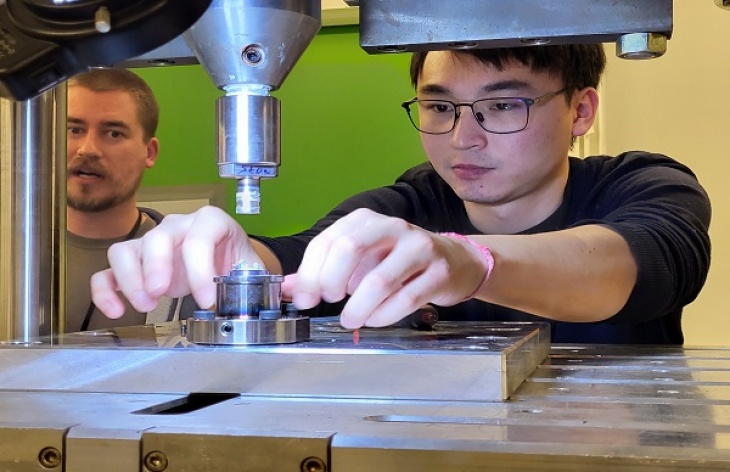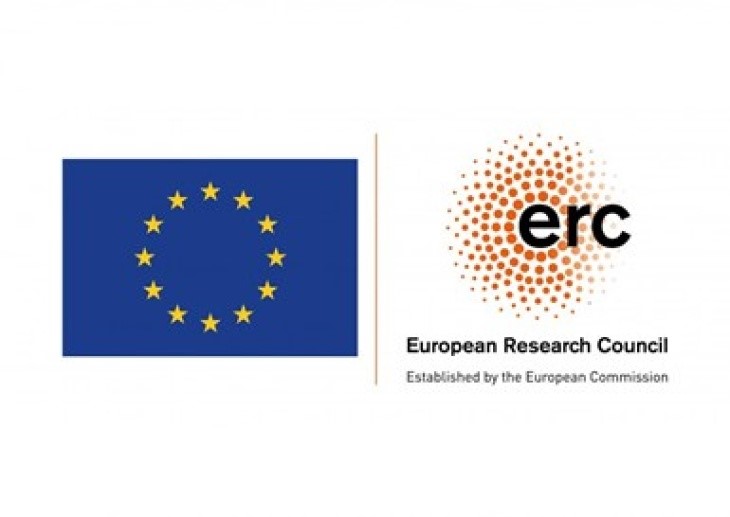Metals for the future
Components for cars and airplanes should be even lighter and more robust in the future - to save fuel and reduce CO2 emissions. This requires optimized materials that have to be produced using new manufacturing processes. The relatively new friction extrusion process is particularly promising. Prof Benjamin Klusemann's department is taking a closer look at this process within his ERC Grant “MA.D.AM” in order to make it work for everyday use. In collaboration with colleagues from Hereon and the Pacific Northwest National Laboratory in the USA, experiments are being carried out at DESY.

The screening in the beamlines helps to better understand the material. (from the left: the scientists Lars Rath and Chang Yin-Cheng Chan) Photo: Hereon/ Peter Staron
Benjamin Klusemann needs a fairly large device for his research - a storage ring with a circumference of 2.3 kilometers, often referred to as "synchrotron source". Klusemann is head of the Solid State Materials Processing department at the Helmholtz-Zentrum Hereon. Together with his colleagues, he researches and processes new metal alloys for the airplanes and cars of the future, which should be both light and particularly robust. But before the metals can take to the skies in large jets, the researchers have to look at the tiniest details, at the micro and nanometer dimensions in the metal.
Klusemann and his team travel to Hamburg to carry out measurements. There, at the German Engineering Materials Science Center, GEMS, is the central user platform of the Hereon with a globally unique infrastructure for complementary research with photons. The instruments that use synchrotron radiation are operated at the outstation at the Deutsches Elektronen Synchrotron (DESY). With a high-energy and intense X-ray beam, which is generated using the electrons stored in the ring, it is possible to look into the metal - and analyze its tiny structure. Ultimately, it is this structure that determines how strong the metal is and how well it can be processed and shaped into aircraft parts.
New alluminium alloys
His team is looking at promising new aluminum alloys, especially those made from a mixture of a lot of aluminum and smaller amounts of copper and lithium as well as other chemical elements. But the mixture alone is not enough. How a material is produced and processed is crucial for its application, especially in terms of deformation and temperature. "Everything together ultimately influences the structure inside the material and its properties," says Klusemann. Specifically, he is interested in a new metal processing method that he uses to shape the aluminum alloy. In this process, the material is not only subjected to high pressure but also to friction in order to process it; in this case into wires that could be used in 3D metal printers in the future, for example. "We are the first in the world to have developed and set up an in situ experiment for the friction extrusion process at a synchrotron source," he says. The development and planning of these experiments was based on the so-called "FlexiStir", a multifunctional friction welding system that was developed together with colleagues from GEMS at Hereon. This cross-institute and cross-departmental development of complex experiments at the synchrotron is one of Hereon's strengths. The departments of Prof Benjamin Klusemann and Dr Peter Staron have been working together for many years.
The development of this test stand is an elementary component of his current ERC grant “MA.D.AM”. An ERC grant is the most prestigious European research grant awarded by the European Research Council and is equivalent to a science prize.
Lighter cars and airplanes
Aluminum alloys have been used in various forms in industry for many years. These include profiles in cars and airplanes, for example in the form of rails into which seats are inserted or those that support the engine or structure in the car body. To shape the alloy into an elongated profile, the material is heated until it is so soft that it can be pressed through a die. This process is known as "extrusion". With the friction extrusion process, which Klusemann is investigating at DESY, it is hoped to achieve even better properties than with more classic approaches. The aim is also to be able to process other materials in the near future.
For his experiments, he clamps small blocks of material into a device, which then presses a punch into the material with a hole in the middle. The novelty: this punch rotates at the same time to generate friction. This heats the material and slowly softens it, allowing it to be formed into wires. The pressure and rotation ultimately result in the material having a different nano- and microstructure than before. With the help of X-ray diffraction, the research group can observe exactly how the structure forms in the material - and even how the aluminum, copper and lithium atoms in the material come together to form small particles. "These nanometer-sized particles make the material particularly resistant despite its low weight," says Klusemann.
More tests in the future
With further tests on the Hereon beamlines at DESY, his team now wants to find out how manufacturing of aluminium components can be further optimized for future production. "To do this, we need to understand even more precisely what happens at the micro and nano level when the material is subjected to both pressure and friction." He is working closely with colleagues from the Pacific Northwest National Laboratory (PNNL), a research laboratory in the USA, where the friction extrusion process has also been studied in recent years. "Our aim is to use X-rays to analyze the material during processing. This is only possible with examinations directly in the material, with so-called in situ measurements, which are only possible in close cooperation with partners with different areas of expertise," says Klusemann. He finds it astonishing that the concept of friction extrusion was conceived back in 1991 but was only implemented for the first time a few years ago in a special machine that is now available at Hereon and PNNL.

This project has received funding from the European Research Council (ERC) under the European Union’s Horizon 2020 research and innovation programme (grant agreement No 101001567)
Further Information
Website ERC Grant MA.D.AM Website German Engineering Materials Science Center (GEMS) Website Hereon Institute of Materials Mechanics
Contact
Head of the Solid State Materials Processing
Institute of Materials Mechanics
Phone: +49 (0) 4152 87-2552
Press Officer
Communication and Media
Phone: +49 (0) 4152 87-1648
